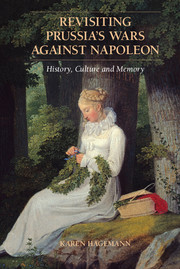Refine search
Actions for selected content:
15418 results in Military history
List of Abbreviations
-
- Book:
- Revisiting Prussia's Wars against Napoleon
- Published online:
- 05 March 2015
- Print publication:
- 30 March 2015, pp xi-xii
-
- Chapter
- Export citation
Prelude
-
- Book:
- Revisiting Prussia's Wars against Napoleon
- Published online:
- 05 March 2015
- Print publication:
- 30 March 2015, pp 1-8
-
- Chapter
- Export citation
2 - Reform and Revenge
-
- Book:
- Revisiting Prussia's Wars against Napoleon
- Published online:
- 05 March 2015
- Print publication:
- 30 March 2015, pp 47-60
-
- Chapter
- Export citation
Plate section
-
- Book:
- Revisiting Prussia's Wars against Napoleon
- Published online:
- 05 March 2015
- Print publication:
- 30 March 2015, pp -
-
- Chapter
- Export citation
Part One - A History of Defeat, Crisis and Victory
-
- Book:
- Revisiting Prussia's Wars against Napoleon
- Published online:
- 05 March 2015
- Print publication:
- 30 March 2015, pp 31-32
-
- Chapter
- Export citation
15 - Re-Creating the Past
-
- Book:
- Revisiting Prussia's Wars against Napoleon
- Published online:
- 05 March 2015
- Print publication:
- 30 March 2015, pp 341-353
-
- Chapter
- Export citation
Name Index
-
- Book:
- Revisiting Prussia's Wars against Napoleon
- Published online:
- 05 March 2015
- Print publication:
- 30 March 2015, pp 463-470
-
- Chapter
- Export citation
3 - Liberation and Restoration
-
- Book:
- Revisiting Prussia's Wars against Napoleon
- Published online:
- 05 March 2015
- Print publication:
- 30 March 2015, pp 61-72
-
- Chapter
- Export citation
Subject Index
-
- Book:
- Revisiting Prussia's Wars against Napoleon
- Published online:
- 05 March 2015
- Print publication:
- 30 March 2015, pp 471-484
-
- Chapter
- Export citation
Conclusion
-
- Book:
- Revisiting Prussia's Wars against Napoleon
- Published online:
- 05 March 2015
- Print publication:
- 30 March 2015, pp 73-74
-
- Chapter
- Export citation
Part Three - Collective Practices of De/Mobilization and Commemoration
-
- Book:
- Revisiting Prussia's Wars against Napoleon
- Published online:
- 05 March 2015
- Print publication:
- 30 March 2015, pp 173-176
-
- Chapter
- Export citation
11 - Honoring and Commemorating War Heroes
-
- Book:
- Revisiting Prussia's Wars against Napoleon
- Published online:
- 05 March 2015
- Print publication:
- 30 March 2015, pp 228-246
-
- Chapter
- Export citation
Part Four - Literary Market, History and War Memories
-
- Book:
- Revisiting Prussia's Wars against Napoleon
- Published online:
- 05 March 2015
- Print publication:
- 30 March 2015, pp 249-252
-
- Chapter
- Export citation
Part Five - Novels, Memory and Politics
-
- Book:
- Revisiting Prussia's Wars against Napoleon
- Published online:
- 05 March 2015
- Print publication:
- 30 March 2015, pp 337-340
-
- Chapter
- Export citation
Conclusion
-
- Book:
- Revisiting Prussia's Wars against Napoleon
- Published online:
- 05 March 2015
- Print publication:
- 30 March 2015, pp 171-172
-
- Chapter
- Export citation
Revisiting Prussia’s Wars against Napoleon
-
- Book:
- Revisiting Prussia's Wars against Napoleon
- Published online:
- 05 March 2015
- Print publication:
- 30 March 2015, pp xv-xv
-
- Chapter
- Export citation

Revisiting Prussia's Wars against Napoleon
- History, Culture, and Memory
-
- Published online:
- 05 March 2015
- Print publication:
- 30 March 2015

Allies in Memory
- World War II and the Politics ofTransatlantic Commemoration, c.1941–2001
-
- Published online:
- 05 March 2015
- Print publication:
- 02 March 2015
3 - ‘These memories shall not be forgotten’
- from Part I - Remembrance and reconstruction,c.1917–1969
-
- Book:
- Allies in Memory
- Published online:
- 05 March 2015
- Print publication:
- 02 March 2015, pp 82-128
-
- Chapter
- Export citation
Dedication
-
- Book:
- Allies in Memory
- Published online:
- 05 March 2015
- Print publication:
- 02 March 2015, pp v-vi
-
- Chapter
- Export citation
